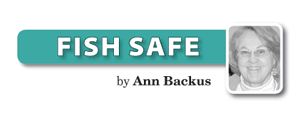As most readers know, fishery observers are trained participants in the National Observer Program of the National Oceanic and Atmospheric Administration (NOAA) who accompany fishing trips.
They observe how much fish and what species are being caught, how bycatch is handled by the captain, and whether the boat is adhering to catch limits.
When the observer program was initiated, it became important to ensure that these observers were not at risk, and that the vessels on which they were observing were safe and compliant with Coast Guard regulations.
To ensure that they were not put in harms way, cohorts of observers were (and still are) given intense safety training.
Prior to a trip, each observer is required to receive an orientation to the vessel and to conduct a safety check. Any deficiencies found by the observer are expected to be rectified prior to trip initiation.
Observers can refuse to join a trip if they find the vessel unsafe or the captain/crew not competent to handle hazardous situations at sea.
I was pleased to learn recently that a group of 24 experts had gathered in Woods Hole, MA this past August to revisit the Northeast Fisheries Observer Program Pre-trip Vessel Safety protocol and the Pre-trip Vessel Safety Checklist (PTVSC).
This article covers some of the highlights of the workshop, and comments noted here were drawn from the workshop report – which is available to the industry and interested parties.
Workshop and findings
The expressed objectives of the workshop, according to the report were:
“To evaluate and produce anything we need to change to make the (observer) safety checklist more safe and efficient.
“Discuss if it is possible to modify current protocols while maintaining program standards, and evaluate risks and impacts to the program, resources, observers, and the industry.”
In a preliminary exercise, the group determined that the safety items on the PTVSC pertaining to vessel orientation, the USCG decal, immersion suits, liferings, and fire extinguishers were satisfactory as they stand.
However, items related to EPRIBs, liferafts, and emergency flares, as well as several aspects of the check list itself, were found wanting.
We should say at the outset, observers begin their safety check by determining if the vessel has an unexpired USCG dockside exam decal. Without that decal, the trip is a “no-go” as far as the observer is concerned.
Regarding EPIRBs and liferafts: An EVIC (EPIRB Visual Inspection Checklist) card is available to observers to prompt them to document whether the EPIRB is properly registered to the vessel, the registration is unexpired, the batteries are serviceable, and the hydrostatic release is unexpired.
The problem raised at the workshop was that only 43% of the trips used EVICs.
For liferafts the problem was different.
As liferafts are located on the roof of the wheelhouse, observers have to climb onto the roof to check the liferaft expiration date and ensure the proper mounting of the hydrostatic release. This climbing maneuver puts the observer at risk.
The proposed solution to these two items was to include the liferaft checklist on the EVIC, change the name of the card to Equipment Visual Inspection Checklist, increase the use of the card by discussing it more thoroughly at trainings, and routinely handing out EVIC cards to observers.
The workshop participants also discussed the possibility of having the observers do the EVIC inspection less frequently, say monthly, rather than for each trip.
Regarding flares: There was mention that flares could have expired and the expiration not have been noticed until the day of the trip.
The solution proposed was for more outreach to the industry, more discussion at the ports, more emphasis on this during observer trainings and also — and perhaps most importantly — having the trip coordinators discuss flares with the captain when setting up trips.
Regarding the Pre-trip Vessel Safety Checklist itself: A number of action steps were suggested.
With respect to frequency, the frequency of the safety check for multi-day trips is currently deemed satisfactory, but it was suggested that the group explore the feasibility of a “per deployment”, or once per week, check for single-day trips to reduce the burden on observers and the industry.
In terms of format, suggestions included bringing the EVIC information to the front of the checklist, reducing the wordiness, marking mandatory items clearly, and considering an electronic data entry scheme such as a tablet.
The workshop participants also discussed the less tangible items of the relationship between the observer and the captain of the vessel.
Clearly, there are times when the observer must confront the captain or owner about a safety issue she/he has found during the pre-trip safety check.
Suggestions included making the industry more aware of the importance and purpose of the PTVSC and providing the observers with sensitivity training and/or conflict resolution skills.
Impact on fleet safety
A Coast Guard representative at the workshop mentioned that in general 20% of the vessels they inspect for decals have safety deficiencies, whereas only 0.5% of the vessels who carry observers have deficiencies.
The Coast Guard has recently added to observer training descriptions of casualties with observers onboard.
The investigations of these casualties have shown that the observer has been “the key person in a successful rescue.”
Ann Backus, MS, is the director of outreach for the Harvard School of Public Health’s Department of Environmental Health in Boston, MA. She may be reached by phone at (617) 432-3327 or by e-mail at <abackus@hsph.harvard.edu>.
FISH SAFE
• Whether or not you carry an observer, arrange a dockside exam with the Coast Guard.
• If you carry observers, consider the extra measure of safety these folks bring to your fishing enterprise.
• If you are an observer, thank you for engaging with the industry around issues of safety.






